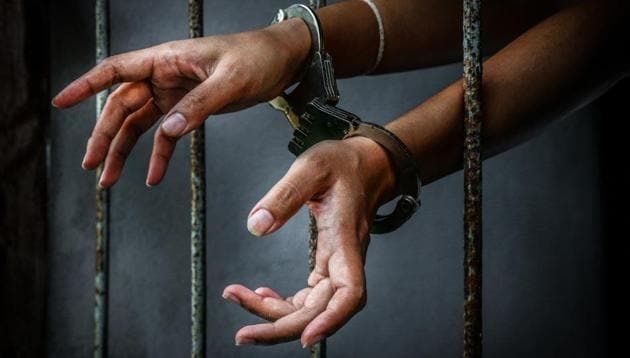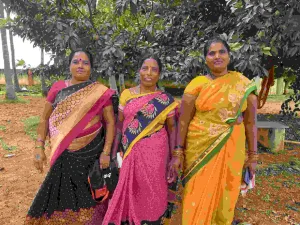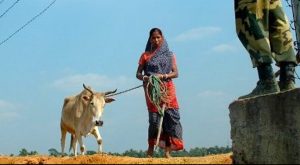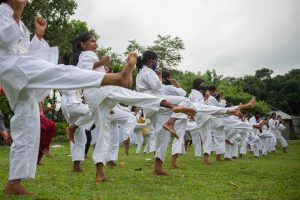Though over a period of time they learnt to bargain for themselves in the brothel and resist the physical and sexual abuse, they still did not have access to the money that they earned. They would call their family members telling them that they were working in a garment factory in Dhaka. As mentioned earlier, they worried that if their family members found out that they were working in a brothel, they would face humiliation and insult. They were apprehensive about the additional psychological and physical violence they would have to experience. Contact with their families was difficult, if not terminated completely, once they were arrested and later imprisoned.
Some of the women such as Shamoli Khatoon, who refused to succumb to the exploitation in the brothel, were punished for their defiance and were handed over to the police. While some were arrested from the brothel itself, others were arrested whilst trying to escape the exploitative conditions in the brothel. Shamoli said:
They sold me for 60,000. . . they took me to a brothel . . . the women there told me that they will not give me any money but I could stay there . . .they wanted to keep me to make me do kharab kaaj (immoral work) . . .I begged them and told them that I will not do any kharab kaaj . . . in the evening around 5 pm they got me arrested.
Once arrested, various forms of violence, especially psychological violence, were to perpetrate their lives both in prison and in various other institutions of the criminal justice system. Bangladeshi women were often taunted in prison for leaving their country and coming to India only to add to the prison population. They were perceived as sexually aggressive and violent in comparison to the Indian woman, who assumedly did not pose as many administrative challenges. More often than not, the Bangladeshi women used the stigma associated with their sexuality to threaten the sharp hierarchies that shape the social life in prison. While the prison staff associated their “aggressive sexuality” with their nationality, the women used the same to assert their identity as a woman, as a survivor and not as a victim.
There was significant antagonism that prevailed in the prison for many reasons, including the constant fight for space and resources. In addition, as discussed, there were multiple hierarchies between the women prisoners (cf.Crewe, 2009). The Bangladeshi women occupied the lowest level in this hierarchy. There were women, who were labelled as pagol [mentally ill], and were at the receiving end of violent behaviour both from the warders as well as the other inmates. They often had few friends and did not get adequate medical attention. With each passing day their depression became more acute. Amongst themselves the Bangladeshi women would engage in moral policing of each other’s behaviour so that they could uphold the image of a “good” Bangladeshi woman in India. While they thought that it was important to question the prison administration, they thought it to be equally important to project the image of a Bangladeshi woman with high moral values, to preserve the maan-shonmaan of their desh. Despite all their efforts, the prison administration often hurled a number of abuses on them. I quote an instance from my field notes:
These Bangladeshis are like beggars. They only know how to fight and abuse each other. These are very dangerous women’, said the female warder to the male guard responsible for the female ward and the latter started laughing. The guard took a look at the jackfruit tree and asked the warder if they cook and eat that. The warder said no they did not because who would pluck them from the tree. The male guard replied, ‘Why do you not tell these Bangladeshis girls to do it. I am sure they are adept at climbing trees. Anyways they are so uncivilised’. (18 May 2011)
Such perceptions often added to the struggles of the women, who tried to reconcile with the complete absence of contact with the outside world. There was a complex relationship between the male guards of the prison and the Bangladeshi women. The former were responsible for chaperoning the female inmates to the hospital or interview room, and they often made use of the walks to have flirtatious conversations. The women, who depended on them for some material benefits or news from outside, often engaged in these conversations whilst simultaneously being at the receiving end of their abuses. It affected their psyche and they felt a loss of dignity.
There were diverse ways in which the women responded to the power relations in which they were embedded. They frequently replicated them while interacting with each other through moral policing, but there were also times when the women came together for a common cause. Often, the common cause that united the Bangladeshi women was protesting delays in their release from the prison. As the day of their release drew closer the anxiety of the Bangladeshi women prisoners increased exponentially. As discussed in the previous chapter, they were anxious about the process through which they would be sent back and the time that this process would involve. They often went on hunger strikes demanding their release once they had served their respective prison terms.
The women spoke of the varying forms of violence that they faced right from the time that they reached puberty, and continued through child marriage, forced marriage, and domestic violence in both natal and marital families, and later still, the violence they faced at the hands of the traffickers or smugglers, violence at the border, violence at the police station, brothels, and prison.
Violence survived, in its various emotional, physical, and material forms, in the lives of the Bangladeshi women on a continuum. The survival of violence in their lives was linked with the survival of the traffickers, the brothel owners, warders, prison administration, as well as the BSF, who appeared to derive material or psychological benefits/pleasure from their acts of violence. Each of these stakeholders violated the bodies of the Bangladeshi women physically and/or emotionally as well by the work they did or the positions they held in the system, which exploited/punished undocumented cross-border mobility.
The different forms of violence tried to confine them, contain them, and restrain them within different kinds of borders and boundaries of the family, community, and state. However, it is important to note that the women, though constantly trying to break through these borders and boundaries, did not label these instances in their life as violent or exploitative. Often it was difficult for them to explain what these instances meant in their lives and how they changed the course of their life. They resisted my questions about violence, but when prodded, they did speak about their experiences and it was a theme that ran through their narratives. But an emotion and experience that they were eager to speak about was prem (love).





